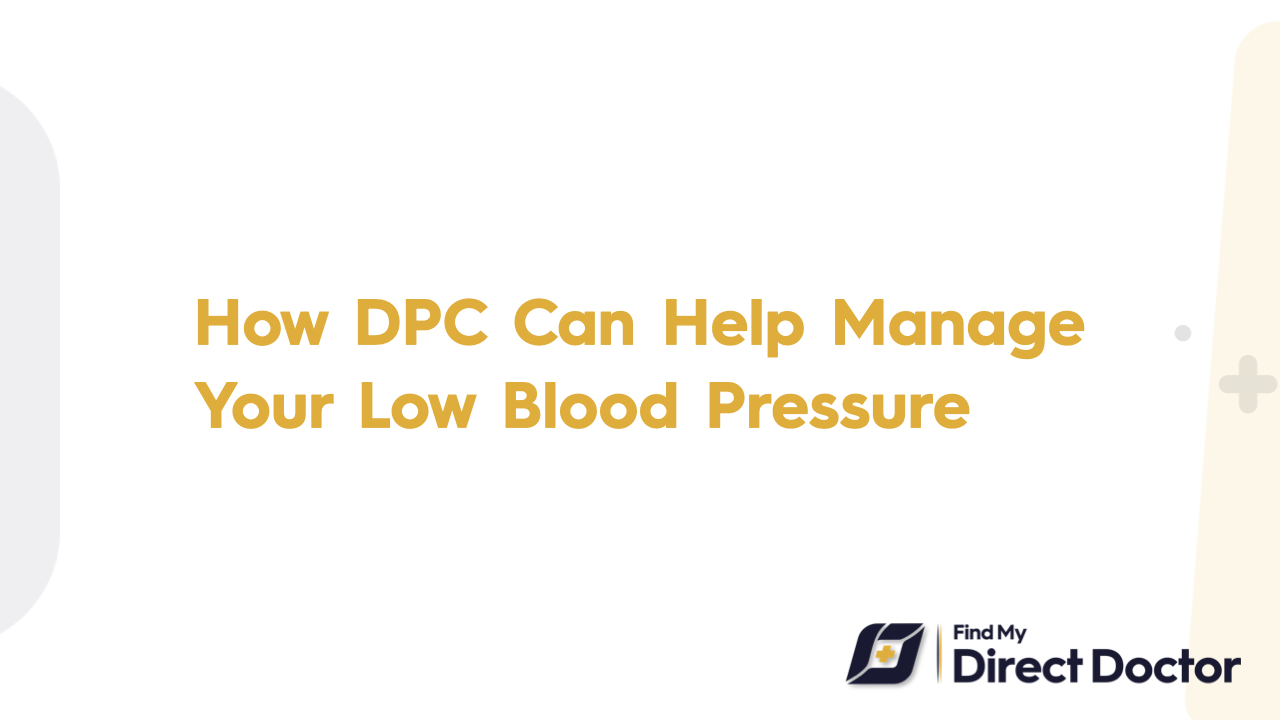Low Blood Pressure and Direct Primary Care (DPC): Personalized Care for Stability and Wellness
You know how uncomfortable low blood pressure (hypotension) can be if you have ever felt lightheaded standing up, battled chronic tiredness, or fainted suddenly. Although usually underlined by hypertension, hypotension affects 7% of adults and causes symptoms that disturb daily life and raise fall risks. Combining comprehensive monitoring, customized treatments, and ongoing support—no insurance hurdles or surprise costs—Direct Primary Care (DPC) presents a patient-centered solution. Let's investigate this.

Knowing Low Blood Pressure
A blood pressure reading below 90/60 mmHg is what defines hypotension. Common forms include:
- Orthostatic hypotension: Dizziness when standing.
- Postprandial hypotension—drops following meals.
- Linked to faulty brain-signaling, neurally mediated hypotension (NMH).
Disorders to treat:
- Lightheadedness, hazy eyesight, or fainting.
- Slowness, nausea, or trouble focusing.
- Rapid breathing or cold, clammy skin.
Long-term dangers of untreated hypotension:
- Falls and fractures (particularly in elderly people).
- Less organ perfusion causing kidney damage or stroke.
How DPC Changes Managing Hypotension
Under the membership model known as Direct Primary Care (DPC), patients pay a monthly fee usually ranging from USD 50 to USD 150 for unlimited access to their provider. For those with hypotension, this means care catered to your triggers and lifestyle, no financial surprises, and no waiting weeks for medication adjustments.
1. Quick Diagnosis and Root Cause Analysis
DPC providers apply evidence-based approaches:
- Testing for orthostasis: To verify orthostatic hypotension, measure BP sitting and standing.
- Holter monitoring looks for arrhythmias causing low blood pressure.
- Rule out dehydration, anemia, or adrenal insufficiency from lab work.
2. Customised Therapy Schedules
DPC guarantees:
- Lifestyle strategies: Paced breathing, compression stockings, more salt and fluid intake.
- Medication adjustments: Midodrine for severe drops or fludrocortisone for chronic conditions.
- Small, low-carb meals to avoid post-meal dips are part of dietary coaching.
3. Constant Observation and Preventive Measures
DPC ensures:
- Bluetooth-enabled devices sync data straight to your provider, tracking home blood pressure.
- Fall risk evaluations include training in home safety checks and balance.
- Yoga or meditation can help enhance autonomic nervous system performance.
Essential DPC Benefits for Low Blood Pressure Patients
- Same-day consultations: Talk about sudden vertigo or near-fainting right away.
- Savings on costs: Steer clear of USD 200+ cardiologist co-pays for normal blood pressure control.
- Whole concentration: Attack root causes including thyroid problems, anemia, or dehydration.
DPC's Personalized Hypotension Management
DPC customizes treatment for your specific needs:
- Customised lifestyle interventions:
- Hydration plans: Drinks high in electrolytes (such as coconut water) for chronic low blood pressure.
- Exercise programs: Swimming or recumbent biking helps avoid orthostatic stress.
- Change your sleep posture by raising the head of the bed to help lower nighttime falls.
- Drug optimization:
- Fludrocortisone for salt-wasting conditions—such as Addison's disease.
- Midodrine doses before high-risk activities (such as standing job).
- Review prescriptions to reduce needless diuretics or anti-hypertensives.
- Comorbidity management:
- Iron infusions or B12 injections correct anemia for deficient patients.
- Coordinating diabetes: Steer clear of overtight glucose control aggravating BP.
- Biofeedback for NMH or POTS (postural orthostatic tachycardia syndrome) is a form of autonomic training.
Real-Life Success Stories
- Case 1: Marta, 68, cut her falls by 80% after her DPC provider recommended compression stockings and changed her blood pressure meds.
- Case 2: Ethan, 24 (NMH), recovered energy with DPC-guided hydration and recumbent exercise, then returned to college symptom-free.
Frequently Asked Questions: DPC and Low Blood Pressure
- Q: Is it possible to cure hypotension?
A: Often not; but DPC's ongoing treatment reduces symptoms and avoids complications.
- Q: For fixed-income seniors, is DPC reasonably priced?
A: Indeed! Usually under USD 100 a month, members save on specialist visits, labs, and drugs.
- Q: Suppose I need a cardiologist?
A: Your DPC doctor shares records for seamless treatment and coordinates discounted referrals.
Why DPC Wins for Hypotension Patients
The direct, unhurried attention of the DPC model is perfect for the fluctuation in hypotension:
- Real-time modifications: Based on daily blood pressure logs, change meds or salt intake.
- Preventive action strategies: Catch anemia or dehydration before crises.
- Teach "pulse" techniques—leg crossing, squatting—to stabilize blood pressure.
Regain Stability and Confidence with DPC
Low blood pressure need not cause you to feel delicate. DPC helps you stand strong and live fully by means of a partner who provides tailored strategies, immediate support, and financial clarity.
- From fall prevention to hydration strategies, DPC helps you take charge of your blood pressure and flourish.
- Transparent pricing—no hidden fees or insurance complications.
- 24/7 access to adjust treatment during sudden orthostatic episodes.






